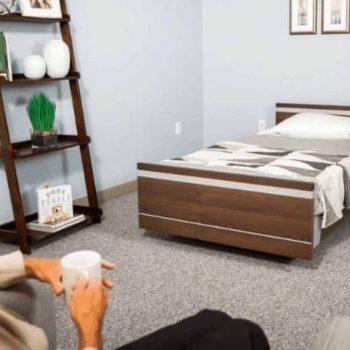
Hospital Beds
How Many Types Of Hospital Beds Are There?
Last Updated –
SonderCare Learning Center

SonderCare Learning Center

Health & Medical Writer
Written & Researched

Hospital Bed Expert
Fact Checker & Commentary
The look and expectations of a hospital bed have been given to most of us from what we’ve seen in movies or in the unfortunate event of an overnight hospital stay. In reality, the designs of hospital beds and the attached amenities and accessories varies quite a bit. For instance, the design of SonderCare’s luxury hospital beds greatly exceed the comfort and function of most hospital beds while retaining the look of a normal residential bed.
The realm of hospital beds and patient care beds includes many variants and innovations based on research and feedback. This is the story of SonderCare’s line of hospital beds as well. Read on to learn about ‘How Many Types Of Hospital Beds Are There?’ plus how they work and what actually makes them so different.
SonderCare Editorial Policy
All of our articles are written by a professional writer and edited for accuracy by a hospital bed expert. SonderCare is a Hospital Bed company with locations across the U.S. and Canada. We distribute, install and service our certified home hospital beds across North America. Our staff is made up of several hospital bed experts that have worked in the medical equipment industry for more than 20 years. Read more about our company here.
All contemporary hospital beds are versatile, and patients can adapt them to their changing needs. What separates the different types of hospital beds is what powers their functions. There are three main types of hospital beds: manual, semi-electric, and fully-electric. However, more types of medical beds exist and they are listed in the table below.
All the hospital beds in the SonderCare line are fully electric, meaning they have functions that increase the ease-of-use and comfort for all people. Patients and clients who don’t have the physicality or strength to operate a manual crank can move their bed independently with a SonderCare full-electric bed.
Orthopedic nurses need to understand how specialty beds can help them more effectively care for the immobilized patient. Ceccio, C. M. (1990). Understanding therapeutic beds. Orthopaedic Nursing, 9(3), 10-16. https://doi.org/10.1097/00006416-199005000-00003
SonderCare beds come in three different models, each fully functional to meet the care needs of clients with sophisticated aesthetics that look at home in any living space:
Hospital models are much more suitable for the comfort needs of patients in recovery than ordinary beds. However, not everyone who would benefit from a care bed has the same comfort needs, which is why you can adjust the bed and its features to suit your particular requirements.
One advantage hospital beds have over ordinary home beds is that they can adjust their height, as well as the head and the foot of the bed. Many patients who are awake in bed prefer to elevate their head, feet, and knees for therapeutic reasons and comfort. When sleeping, many patients require a flat, level surface to get the rest they need; when resting while awake, they can adjust to a seated position to read or watch television. Different models bring different settings for posture adjustment.
There is a wide range of hospital beds available today, all with different styles, designs, and features to fit a wide array of budgets. While virtually all hospital beds can offer some comfort and relief, less expensive beds will often forgo some of the safety, style, and advanced positioning features.
A multidisciplinary task force looked at current use of specialty beds, clinical appropriateness of past decisions regarding use of these beds, and education of staff members. Russell, T., Logsdon, A., & Lohman, J. A. (2001). A medical center’s experience with managing specialty bed usage. Journal of Wound, Ostomy, and Continence Nursing, 28(5), 255-261. https://doi.org/10.1067/MJW.2001.119011
SonderCare hospital beds are readily available for use in homes and private facilities, combining the functionality of a healthcare center with the comfort of an ordinary bed for private settings. With luxurious looks and relaxing adjustable features, our beds are available in several sizes and have many helpful accessories that don’t feel like medical equipment at all.
The best hospital beds have luxury elements to bring more options and adaptability. Features like stylish headboards and footboards, multi-height assist rails, and various sizes mean patients and their families can get the right model for their needs.
The National Disaster Medical System (NDMS) also defines five distinct categories of hospital beds:
Medical-Surgical Beds: These are standard hospital beds that are used for the care of patients with medical and surgical conditions. They are typically used for patients who are stable and do not require critical care.
Critical Care Beds: These beds are intended for patients with life-threatening conditions who require continuous monitoring and support. They are equipped with advanced monitoring and life-support equipment.
Burn Beds: These beds are specifically designed for patients with burn injuries. They are equipped with specialized burn care equipment and staffed by personnel trained in burn care.
Pediatric Beds: These beds are designed for the care of children and adolescents. They are staffed by healthcare professionals trained in pediatrics and equipped with specialized pediatric medical equipment.
Psychiatry Beds: These beds are intended for patients with mental health conditions and are staffed by mental health professionals. They are equipped with specialized equipment and facilities for the care and treatment of patients with psychiatric conditions.
These bed categories help ensure that patients receive the appropriate level of care for their specific needs and conditions.
| Type of Hospital Bed | Description | Related Concepts |
|---|---|---|
| Manual bed | Raised and lowered manually by a crank or a hand-held control. | Crank, hand-held control, manual labor |
| Electric bed | Raised and lowered using an electric motor. Can also be adjusted to different positions. | Electric motor, remote control, electronic equipment |
| Bariatric bed | Designed for patients who are overweight or obese. Wider and sturdier than a standard bed. | Overweight, obesity, patient size |
| Low bed | Designed for patients at risk of falling out of bed. Lower to the ground than a standard bed. | Patient falls, bed height |
| Trendelenburg bed | Used to position patients in a partially upright position to help with breathing or circulation. | Patient positioning, breathing, circulation, medical treatment |
| Reverse Trendelenburg bed | Used to position patients in a partially inverted position to help with breathing or circulation. | Patient positioning, breathing, circulation, medical treatment |
| Pediatric bed | Designed for children. Smaller in size than a standard bed. | Pediatrics, child-sized equipment |
| Birthing bed | Used during childbirth. Equipped with features such as stirrups and a headrest. | Childbirth, stirrups, headrest, obstetrics |
| Hospice bed | Designed for patients receiving end-of-life care. Equipped with rails and safety features. | End-of-life care, patient safety, palliative care |
| Intensive care bed | Used in the intensive care unit. Equipped with features such as a bed rail, an IV pole, and a headrest. | Intensive care unit, bed rail, IV pole, headrest, medical equipment |
| Isolation bed | Used for patients in isolation due to an infectious disease. May have a privacy curtain and a built-in sink. | Infectious disease, isolation, privacy curtain, built-in sink, infection control |
| Air mattress bed | Used to prevent pressure ulcers. Equipped with an air-filled mattress that adjusts to the patient’s body. | Pressure ulcers, air-filled mattress, bed sores, patient comfort |
| Hospital cot | Portable bed that can be easily moved. Used for short-term stays or in emergency situations. | Portability, short-term stays, emergencies, mobility |
| Stretcher bed | Used to transport patients from one location to another. Equipped with wheels and can be adjusted to different positions. | Patient transport, wheels, patient positioning, medical transport |
A simulation model to aid decision making in the area of operating theatre time tables and the resultant hospital bed requirements and types leading to the NDMS Medical Bed Categories. Harris, R. A. (1986). Hospital bed requirements planning. European Journal of Operational Research, 26(3), 304-311. https://doi.org/10.1016/0377-2217(86)90121-9
From Our Experience... "As a senior executive involved in the medical equipment industry and after having over 30 years of experience with hospital beds in acute care, nursing, rehab and home care I can say without a doubt that being able to choose the type of hospital bed that is right for the situation has a direct impact on care and recovery. I've seen this time and time again and it keeps inspiring me to work hard in this industry providing the types of hospital beds that make a difference in people's lives. "
Kyle Sobko Hospital Bed Expert
A manual hospital bed is a type of medical bed designed for use in healthcare settings and home care environments, offering basic adjustments to accommodate the needs of patients and caregivers. Manual beds rely on hand cranks or levers to adjust the bed’s height, head, and foot sections and these constant manual adjustments can help improve patient comfort, facilitate medical care, and assist with transfers to and from the bed. Manual hospital beds are generally more affordable than their electric counterparts, making them a practical option for facilities with budget constraints or for short-term use. Medicare/Medicaid often provide these beds. However, they may not be suitable for patients requiring frequent position changes, as the manual adjustments can be labor-intensive for caregivers. Despite their limitations, manual hospital beds still provide support and comfort for patients in various healthcare situations.
A semi-electric hospital bed is a type of medical bed that combines features of both manual and electric hospital beds, offering a balance between functionality and affordability. These beds provide electrically powered adjustments for the head and foot sections, allowing for quick and easy position changes with the push of a button. Meanwhile, the bed’s height adjustment is typically managed manually using a hand crank or lever. Semi-electric hospital beds are well-suited for patients who require frequent position changes for comfort or medical reasons, but do not need the full range of electric adjustments. They can help reduce a small amount of the physical strain on caregivers while still being relatively budget-friendly compared to fully electric beds. Medicare/Medicaid often provide these beds.
A fully electric hospital bed, also known as a powered medical bed of fully adjustable hospital bed, is a medical bed designed to offer the highest level of convenience, comfort, and functionality for both patients and caregivers. Fully electric beds are equipped with electrically powered controls that enable smooth and effortless adjustments of the bed’s height, head, and foot sections at the touch of a button. These beds are particularly beneficial for patients who are fully bedridden, have limited mobility or those who require frequent position changes for medical reasons, as they largely reduce or eliminate the physical effort required by caregivers. Additionally, some fully electric hospital beds may offer advanced features such as Auto Contour, Chair Position, Trendelenburg and Reverse Trendelenburg positioning, which can help manage specific medical conditions or facilitate certain procedures. Fully electric hospital beds often come with extra features such as integrated side rails, customizable mattress options, and built-in storage compartments to further enhance patient comfort and safety. However, because of the many extra features and luxury design they tend to be more expensive than other medical beds, making them a more significant investment for healthcare or home care. Despite the higher cost, fully electric hospital beds provide unparalleled convenience and adaptability for the widest range of patient care needs.
This is SonderCare’s specialty and a preferred method of care for loved one’s wishing to maintain comfort and ease of use. A pendant or remote allows the patient to adjust the bed’s elevation and orientation. SonderCare bed users often remark at how easy it is to enter and exit the bed or to elevate the mattress to a comfortable height so that the caregiver can efficiently do their duties such as changing, repositioning, cleaning or treating the occupant.
A bariatric hospital bed is a specialized medical bed designed specifically to accommodate the unique needs of bariatric patients, who are individuals with a higher body weight or larger body size. Bariatric hospital beds are engineered to provide enhanced support, safety, and comfort for patients by featuring a more substantial weight capacity, wider dimensions, and reinforced construction compared to standard hospital beds.
A low bed is designed for patients who are at risk of falling out of bed. It is lower to the ground than a standard hospital bed to reduce the risk of falls.
A Trendelenburg bed is used to position patients in a partially upright position to help with breathing or circulation.
A reverse Trendelenburg bed is used to position patients in a partially inverted position, while a Trendelenburg bed positions patients in a partially upright position.
A pediatric bed is designed for children and is smaller in size than a standard hospital bed.
A birthing bed is used during childbirth and is equipped with features such as stirrups and a headrest to assist with delivery.
A hospice bed is designed for patients who are receiving end-of-life care. It is typically equipped with rails and other safety features to prevent falls.
An intensive care bed is used in the intensive care unit (ICU) and is equipped with features such as a bed rail, an IV pole, and a headrest.
An isolation bed is used for patients who are in isolation due to an infectious disease. It may have features such as a privacy curtain and a built-in sink to help prevent the spread of infection.
An air mattress bed is equipped with an air-filled mattress that adjusts to the shape of the patient’s body and redistributes pressure to help prevent pressure ulcers.
A hospital cot is a portable bed that can be easily moved from one location to another. It is typically used for short-term stays or in emergency situations.
A stretcher bed is used to transport patients from one location to another, such as from the ambulance to the hospital. It is equipped with wheels and can be adjusted to different positions to ensure the comfort and safety of the patient during transport.
Start Exploring Hospital Beds With SonderCare
Are you recently discharged from hospital, experiencing mobility issues, or in need of palliative or senior care? Enjoy a smoother recovery and get the luxury you deserve by choosing our home hospital products. Contact us today to discuss home hospital beds, mattresses, stand assist chairs and other accessories to make your home hospice perfect for a truly comfortable experience.